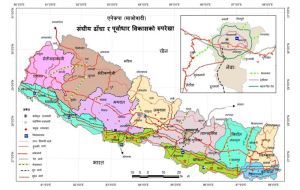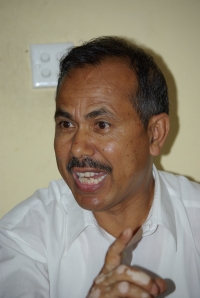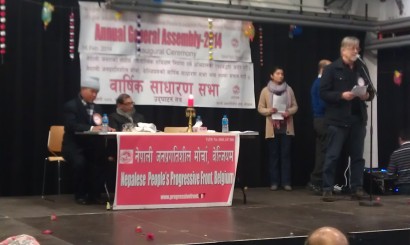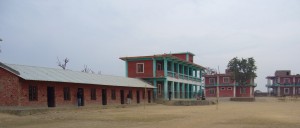The Health Team for Nepal (HfN) supports the democratic revolution in Nepal and has not taken a position concerning the split that has led to the formation of the Communist Party of Nepal (Maoist) (CPNm) as an alternative force to the United Communist Party of Nepal (Maoist) (UCPNm). We are channelling our support to the Martyr Foundation of Nepal where both organisations have influence.
It looks like that there will be elections for a new Constituent Assembly on the 19th of November 2013 where the UCPNm will be participating, while the CPNm is actively boycotting.
As a part of our work to monitor the developments in Nepal and to better understand the political situation as it is unfolding, we have conducted an interview with a representative supporting the CPNm and an interview with UCPNm.
These interviews are published here on our web site in both English and Norwegian.
Interview with Gorkha Bishnu, advisor to the Nepalese People’s Progressive Front Belgium.
24.10-2013.
HfN: It looks like there will be elections for a new Constituent Assembly on the 19th of November and that CPNm and a group of smaller parties will boycott these elections.
Could you tell us a little about the size and influence of the CPNm and their allied parties?
Firstly, we can say that politically and ideologically the CPNm is sole leader of the movement of New Democratic revolution in Nepal. This movement encompasses the movements for National Sovereignty and People’s Supremacy. There are also other forces that are patriotic and oppose foreign interference in Nepal. It is of course during these times a need to ally with those forces in the struggle against the fascists and national traitors. The drama surrounding yet another election to a Constituent Assembly is completely in the interests of the feudals and fascists of Nepal and their allies, the foreign expansionists. The elections are not in the interest of the Nepalese People or their freedom. The class character of the drama surrounding the elections has been exposed. The CPNm is well integrated with the Nepalese People. So, I could say that the CPNm is the central power centre against the regressive line followed by the so called four political parties and their allies.
The party has successfully formed its organizations on village level and in all districts too. It is now in the position to challenge the regressive forces.
HfN: The CPNm has demanded that the prime minister resign from his post as Chief of Justice. Why?
We struggled hard to abolish Monarchy in Nepal. Many good sons and daughters contributed their lives in this struggle. The so called four political parties dissolved the Constituent Assembly and put the nation in a deep crisis. Consequently, they became political failures. So, they cannot lead the nation. Instead of seeking a new, forward looking democratic political solution, they undermined the multiparty democratic system and handed over the state power to the Chief of Justice. This is practicing fascism and against the people’s mandate.
HfN: The CPNm has demanded a round table conference before the election. Why does this have to be before the election? Wouldn’t the representatives that get elected into the Constituent Assembly be representative of the will of the Nepali people?
A round table conference before the Constituent Assembly can be the best option to reach a broad political agreement. This conference should be a formal and legal institution. It is very important in two ways. Firstly, we need to evaluate the efforts of the representatives in the first Constituent Assembly and to accept the contents of the interim constitution that was already agreed upon. Secondly, the political parties need to seriously realise the mistakes they did in the Constituent Assembly. It is clearly known that the so called four largest political parties stood against the agenda of federalism on the basis of identity and oppressed position. The political parties must promise to agree on the agenda before the conference.
HfN: What would be the agenda of a round table conference?
A roundtable conference should mainly treat the two above mentioned agendas. When we look at the manifestos of the political parties for the new election, we see that they have nothing new in relation to the previous elections in 2008. They look even more promising and are in reality sticking to an anti-autonomous ideology. UCPNm proposes autonomy on the basis of Nationality and exploited region. But history has proven that this party already has left the ideology of the New Democratic Revolution, the road of Marxism-Leninism-Maoism. They already follow the revisionist line and openly serve the foreign powers. In the last Constituent Assembly there was a two third’s majority on the proposal of federalism on the basis of indigenous nationality and oppressed regions. In that situation, Prachanda –President of UCPNm and Coordinator of High Level Dispute Committee –and Baburam Battharai, Vice President of the UCPNm and the then Prime Minister dissolved the Constituent Assembly. This clearly proves that the leaders of the UCPNm themselves acted to avoid the agenda of federalism with autonomy in the interests of expansionist and imperialist forces. So, the four political parties want to form a new Constituent Assembly in which the majority of the representatives will be against the restructuring of the nation. We can imagine the horrific scene of the elections and their results in advance. They are controlled by the military and under the leadership of the feudal PM Regmi. So, the roundtable conference is to stop all the regressive moves and to establish national sovereignty and people’s supremacy.
HfN: The CPNm says that they will boycott the elections peacefully. What type of actions are they planning? Why are they ruling out more forceful actions like disrupting the poll?
As these elections are promoting fascism in Nepal the Nepalese people will oppose and destroy them. There will be massive peaceful people’s awareness programmes and an anti-election campaign throughout the country. If the government suppresses the movement of the people, they have right to resist and revolt. CPNM of course will lead it.
HfN: During the last elections in 2008 approximately 63 % participated in the polls. What kind of turn out do you expect this time? Would you consider that the campaign against the elections has failed if the turnout is 60 percent?
No. If you compare the number of voters in 2008 and 2013, you will find less number in 2013. It is the effect of the campaign. The Government uses hook and crook to increase the amount of voters. Voters of Indian origin are mainly motivated to register. Thousands of Indian citizens have been granted Nepalese citizenship in the run up to the elections. These elections are absolutely meaningless for the people. In the manifesto of the CPN-UML they mention that if there is no constitution within a year, the country should have a referendum. They, themselves, have no belief in the Constituent Assembly. There is a big section of intellectuals, lawyers, journalists and so on who have not registered in the voters’ list. Politically, the CPNm is already in a winning position.
HfN: A central demand during the people’s war was land reform. There has not been any land reform, even though the Peace Accord and the Interim Constitution contained points on this. On the contrary some of the land occupied during the people’s war has been given back to the original owners without the introduction of a land reform. What is the role of the CPNm in this situation? What are the main paroles and actions?
The contents you mentioned are central parts of the agenda of the new democratic revolution. It took time to understand that Prachanda gave up the revolution and instead created the peace accord and the interim constitution. So, the issue of land reform in the peace accord and interim constitution was not real. Later on, the achievements of People’s War have been given up one by one. When we became aware of the evil intent of Prachanda, we struggled intensely against neorevisionism. We are determined to complete the new democratic revolution in Nepal .It is only this revolution that can solve the problems you mention.
HfN: In the last Constituent Assembly there was almost 30 % representation of women. It seems that there will be a strong decrease in the representation of women after new elections. What are your remarks on this?
In the last Constituent Assembly election, there was a strong motivation from the People’s War for women’s participation. People’s War established different autonomies on the basis of indigenous nationality and exploited regions. Likewise specific rights were given to women and to so-called untouchable casts, Muslims, some diminishing communities, handicapped and so on. The People’s War gave strong motivation women’s participation. Now, they do not believe that they can guarantee their rights through these elections. So, the women’s participation is decreasing.
HfN: An important issue in today’s Nepal is federalism. What is CPNm’s position on the number of states and the relation between these states and the larger national minorities?
As I mentioned above, CPNm is for autonomous regions on the basis of indigenous nationalities and regions having a central role for some years, specific rights for women, for untouchable casts, for Muslims, for some diminishing communities, handicapped and so on.
HfN: The Terai has seen a massive growth in population relative to the rest of Nepal and there is at the same time controversy concerning the Madhesh issue. What is CPNm’s attitude to the Madhesh-question?
We are struggling for the right of the Nepalese People and they are of course Madheshi People too. While restructuring the country, if measures aren’t taken to bring the workers and farmers and oppressed to have the leading role in the struggle for autonomy, the same situation as in the old system will continue to exist. History shows that the ruling class does not let the workers and farmers become rulers. This is the central question of struggle now throughout the nation and the Madheshi people as well.
HfN: How do the CPNm formulate their political general line in the situation in Nepal today? How do they see the rise of people’s power in Nepal?
Politically, Nepalese People should struggle against the neo revisionism protected by expansionism. The goal of holding the elections to the Constituent Assembly in Nepal is to lengthen the time of the feudals and revisionists. So it is the duty of the Nepalese People to resist the elections.
HfN: What is the content of the expression “people’s revolt” that is sometimes used by members of CPNm?
Nepalese People have been living for decades in poverty and misery. They carried out 10 years of People’s War and many peaceful movements to establish their rights. But their efforts all went in vain. In all the historic moments some of the leaders of the political parties betrayed them and their struggle ended without any achievement. This negative history of the Nepalese People should be broken with and the people should revolt themselves in order to have a complete change and shattering the old state . It is a necessary way of struggle and CPNm will lead it. I see a bright future for the People’s Revolt in Nepal.
HfN: Do you see any possibility of party unification between CPNm and UCPNm in the near future?
In this context I do not see any possibility of party unification. If the UCPNm completely realized its mistakes and came to CPNm it could happen.
HfN: How does the CPNm communicate with English reading people on the internet?
The International Department issues a bulletin called People’s Voice.
——————————————————————————————————————————————————————————————————–
Interview with Krishna Aryal, representative of UCPNm in Europe.
HfN: What is your main goal for the elections for a new Constituent Assembly (CA)?
UCPNm: The main goal of the election for a new CA is to institutionalize the achievements gained in the past by the 10 years long people’s war and people’s movements. The achievements, like the People’s republic of Nepal, a secular state, rights for the ethnic minorities-, oppressed communities- and oppressed gender, the abolition of regional discrimination: All this must be capitalised by writing a constitution, “Federalised with the identity and constitution with federalism” based on a fresh mandate. As outlined in the party’s election manifesto, it will be attempted to write the constitution within a year. This is a commitment to the people. The first half year will be utilised to create a necessary consensus among the political parties. If one fails to get consensus, the next half year will be used to settle the most debated issues by voting. The debated issues are a new governing system, federalism with identity and the capacity and the number of autonomous states. A new rule and order will be made after the new constitution. The period up to the next election will be used for developmental issues in the country.
HfN: What is your aim as to representation in the CA from your party for women?
UCPNm: The issue of gender discrimination will be addressed in the new constitution. Women representatives must play an active role to address their rights in politics, property, education and employment. Women candidates will be given maximum priority so that they will have a decisive presence in the CA. Some of the most important gender issues are equal rights, equal opportunities and equal payment for the same work and qualification.
HfN: What is your aim as to representation for Dalits and indigenous minorities?
UCPNm: The aim is to have representation for Dalits and indigenous minorities and to address the issues of oppressed and marginalised people in society. Dalit communities, ethnic minorities and other minority groups wish to secure their rights in the new constitution. This is also important because of the aim of people’s war was to give rights to the Dalits and indigenous minorities. Our party has been struggling for social justice and identity.
HfN: The CPNm and 32 other parties are boycotting the elections. There was a 63 percent participation rate in the elections in 2008. Would it be a victory for the CPNm and its allies if the turnout was under 60 percent?
UCPNm: Among the 33 parties, CPNm, Limbuwan and Khambuwan are active in boycotting the CA election. Other smaller parties have nominal presence. Some of the parties are taking part in CA election, whereas some of them have strongly opposed the on-going physical attacks on UCPNm’s candidates. Although boycotting the CA election is said to be remain peaceful, CPNm has been aggressive. There have been many attacks in several districts. This means that the 33 parties are divided and split among themselves. The government has been planning to provide extra security for the candidates and the people. It is expected that people will be allowed to come and cast their votes freely without any fear. According to the Election Commission and media sources, there are around 12.5 million people registered and have their identity card with a photograph. The ID-card is mandatory for voting. This registered number seems to be about 4.5 million less this time compared to the numbers in the last CA election in 2008. The main reason for less registration is missing the deadline for registration. Many are working in foreign countries. Some people may have lack of interest in voting for new CA due to frustration from the last CA which could not give a new constitution. Some people may have not registered intentionally to boycott the election.
A person must be present on the Election Day with his/her own ID-card in order to vote. The voting percentage in the CA election in 2013 is expected to be more than 70 percent of the registered number.
HfN: What is your impression of the size and influence of the CPNm?
UCPNm: CPNm has said “boycott CA election peacefully”. The party CPNm has only a few cadres and supporters. Boycotting the CA election will have very little influence. Many of the supporters of CPNm may cast their votes to for the UCPNm and its candidates. On the other hand, people may not cast their votes due various reasons. Those who are absent from voting, are not necessarily supporting CPNm.
HfN: An important issue in today’s Nepal is federalism. What is UCPNms position on the number of states and the relation between these states and the larger national minorities?
UCPNm: The election manifesto has outlined 11 autonomous states. Two states are based on geographical regions, whereas nine states are based on ethnicity. These states are: Seti-Mahakali, Bheri-Karnali, Tharuwan, Magarat, Madesh, Tamuwan, Newa, Tamsaling, Kiart, Limbuwan and Kochila as shown in the location map. Under these autonomous states, there will be 24 autonomous centres based on ethnic minorities. These states will have special rights as to participation in the policy making process. The largest ethnic group within a state will also have special rights for representation as a leader for a limited period.

HfN: The Terai has seen a massive growth in population relative to the rest of Nepal and there is at the same time controversy concerning the Madesh issue. What is UCPNm’s attitude to the Madesh-question?
UCPNm: The Terai region will be arranged into three major autonomous regions: Thauruwan in the west, Madesh in the middle and Kochila in the east. The Madesh state will have three sub-states: Awadh, Mithila and Bhojpura. The ethnic minorities will have special rights to participate in the state power. The biggest ethnic group within a state will also have special right to representation as a leader. Madesh issues will be solved when the federal system based on identity has been established. It will be solved by Nepalese people without any assistance from external forces. Madeshi people will have their respect in society and educational and employment rights.
HfN: In the party programme from the 7th Congress, one of the points is the development of cooperatives in many economic areas. How far have you advanced in this programme?
UCPNM: As per the party programme from 7th Congress, a few cooperatives have been started in some economic centres. The plan is to extend into new areas. There will be at least on cooperative established in each electoral centre. There are at the moment 240 electoral centres. Farmers and local industries will be encouraged to participate in the cooperatives. The state under UCPNm leadership will support the operation and management of such cooperatives.
HfN: What is your goal for the cooperatives role in the economy in relation to the other forms of economic activity like capitalistic firms, state-controlled firms, etc?
UCPNm: Cooperatives will be the back bone of national development. The plans and policies will be made to run the cooperatives properly. The grassroots people will be encouraged to take part and be most benefitted. The prices of various goods will be regulated by selling products for minimum profit at subsidised prices. There will be a great number of participants through collective investment. These cooperatives will be managed under production brigades by gathering individuals, small scale production enterprises and professionals.
HfN: A central demand during the people’s war was land reform. There has not been any land reform, even though the Peace Accord and the Interim Constitution contained points on this. On the contrary some of the land occupied during the people’s war has been given back to the original owners without the introduction of a land reform. What is your role in this situation? What are the main paroles and actions?
UCPNm: Report from the high level scientific land reform commission will be implemented under the leadership UCPNm. The land above a certain threshold will be taken over by the state and will be distributed among the landless. A revolutionary land reform policy will be implemented on the principle of “land for those who plough it”. Excessive land occupied by landlords will be distributed to the landless people, poor farmers and bondage labours.
Agriculture is the main profession in Nepal. More than 70 percent of the people are engaged in the agriculture. The farming methods are very traditional. Farming will therefore be modernised and professionalised. A new agricultural policy will be formulated with a provision for pension to the farmers. Small scale farmers will be encouraged to organise in cooperatives. Barren land will be distributed to the farmers to cultivate.
HfN: What is your explanation for the increased class differences in Nepal in the period between 2008 and 2013?
UCPNm: The increased class differences are caused mainly because of price increases in goods and land. The cost of daily consumable goods and land has drastically been increased the last ten years. The high price of commodities has made survival increasingly difficult for the poor people. There are very few industries that can produce necessary goods for the country. For example, a farmer has to rely on the supply of fertilizer from the foreign countries.
On the other hand, people have very limited job possibilities. As a result, young people have to leave the country seeking for work. This has drained the workforce out of the country. The elderly people cannot cultivate their land which then remains barren. The agricultural production has thus been reduced. This has affected the gross domestic production. These are some of the reasons that the poverty level has increased in the country and the class difference is larger. But this difference is expected to be lowered once a stable government under the leadership of the UCPNm is formed in the future.
HfN: How would you summarize your main political line in this period in the history of Nepal? How do you see the rise of people’s power in Nepal?
UCPNm: The present political situation in Nepal is at a critical juncture. The transition period has been longer than expected. A new constitution could not be written by the last CA due to larger differences between UCPNm and the parliamentary parties. However, UCPNm has been a major and decisive political force since last CA elections in 2008. Our political line is to lead the country and fulfill people’s desires through peaceful means. Now the party is going ahead rectifying its weaknesses with open politics. Due to lack of political understanding among the political parties, the UCPNm government fell after nine months in power. Later the coalition government could not even bring forward a budget due to opposition. The party will try to establish a good relationship with people as well as with the political parties for a new constitution within a short period.
HfN: Do you see any possibility of party unification with CPNm in the near future?
Smaller parties, party leaders from other parties as well as from CPNm are being united into the UCPNm as an ongoing unification process. A large flow of people have joined the UCPNm just before the new CA elections. This is an encouraging situation for party unification with other parties. However, there is no such party unification possibility with the CPNm. Nevertheless, if the national political scenario changes, there is a possibility of unification with the CPNm in the future. Society cannot be changed without a united proletarian force. All the communist parties must unite and form a united communist party centre. UCPNm is leading the unification process.
HfN: How do you communicate with English reading people on the internet?
UCPNm: English publications will be published regularly by the international bureau and the publication department under the leadership of the party. However, this has been irregular in the past, but the party will give priority for English publication in the future.




